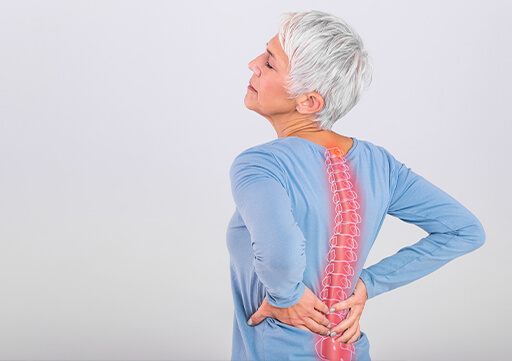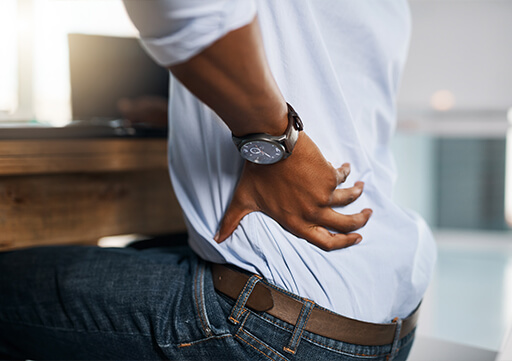Back pain is very common, and it affects people of all ages. Most people experience it at some point in their lives. Sometimes it can be temporary, but in most cases, it develops into chronic pain. Age, genetics, fitness level, and job-related factors are some of the reasons why people suffer from back pain.
Why Do I Have Back Pain?
Above is the most common question asked when people experience recurring back pain. Our back is complex and is sensitive structure.
It is a carefully arranged structure of bones, muscles, joints, tendons, ligaments, spinal cord, and nerves. Any injury or discomfort in any of these components can cause back pain- ranging from mild discomfort to excruciating pain running down to legs and even loss of bowel or bladder function. Though the pain may occur anywhere in the back, lower back pain(lumbago) is the most common type.
Whilst its difficult to deduce the exact cause of this condition in every case, it may have occurred due to the following reasons- your lifestyle, lack of exercise, being overweight, disk problems, or ageing.
Psychological factors like stress, anxiety, and depression also cause back pain. If you are female, you may have a few more reasons; pregnancy, hormonal imbalance, menstrual pain, childbirth, and abdominal weight gain causing a strain on the lower back structures

Some of the most common activities that cause back pain are
- Poor sitting and sleeping postures
- Sitting or standing for a long time,
- Lifting heavyweights in the gym or squatting or deadlifting heavy weights with poor form
- A sudden awkward movement like a twist
- Sitting in a car or office chair for long periods
- Certain sports movements
Why Do I Get Back Pain When I Stand?
Some people experience lower back pain after prolonged standing, whereas others experience pain getting up from a sitting position. The latter is usually because of muscle stiffness (paraspinal muscles) that comes with prolonged sitting. It may also be due to facet joint pain or pain from a bulging disc
Facet joints (the joints that connect the joint of the spine) are squeezed together while standing, which adds more pressure to the painful joints and causes further pain. In contrast, postural stress is the main reason for back pain from prolonged standing. Standing for too long puts pressure on your lower back muscles, often causing pain.
Why Do I Get Back Pain When I Sit?
Bad posture, precisely slouching, is the main reason for lower back pain while sitting. When you slouch, your lumbar spine bends forward while the pelvis slides out. This, in turn, over time, causes stress in the lumbar spine, leading to back pain.
Common Causes of Back Pain:
- Damaged discs (degenerative disc disease)
- Muscle spasm
- Fracture or injury from falls or accidents
- Osteoporosis
- Strain in muscles or ligaments
- Spondylosis
- Spinal stenosis
- Herniated disc/bulging disc
- Abnormal curvature of the spine (scoliosis or kyphosis)
- Kidney infection
- Cancerous spinal tumours
- Sciatica
- Fibromyalgia
Symptoms of Back Pain

The symptoms and intensity of back pain differ with each person. Sometimes they may occur immediately after a particular activity or without any obvious reason.
In some cases, pain also develops much later after an injury or strain. It can be a dull aching pain or a severe shooting pain that affects your daily life. It can also cause difficulty walking or moving your body. If you develop a fever, back pain, night pain, weight loss along with bladder or bowel issues take immediate action and seek urgent medical care.
Diagnosing Back Pain
Usually, diagnosing the cause of your back pain takes time as several conditions can cause back pain. Your doctor might identify and conclude an exact cause only after examining your complete medical history, physical examination, and lifestyle, such as your occupation.
They may run a series of blood tests, bone scans, CT and MRI scans and X-rays, to check for any bone disorder, fracture, infection, or neural disorder. However, the cause of chronic lower back pain isn’t always easy to diagnose even after a thorough examination.
Treatment of Back Pain
There are many treatment choices for back pain. Sometimes self-treatment like ice packs, hot compressions, or topical pain relief is enough to ease the pain
If this doesn’t work and the pain does not get better, you must seek medical advice immediately. Depending upon the severity of your medical condition, your physician may suggest one or a combination of treatments.
Exercise
Some exercises are good in relieving back pain by increasing the core strength of the muscles surrounding the spine. There are exercises to treat many kinds of lower back pain. Low-impact aerobics, swimming, strength training, walking, yoga, and stretches are good options. We advise to discuss the exercises you do with your therapist to ensure you are not doing anything to make the pain worse. Certain exercises can actually exacerbate back pain.
Following the prescribed rehab exercises can help strengthen your back structure and make your recovery from back pain faster than would be otherwise.
Chiropractic Treatment
Chiropractors perform a comprehensive physical and neurological examination to identify the cause of back pain. They use therapeutic exercises, spinal traction, and treatments like soft tissue therapy to treat back pain.
Spinal Injections
If you are suffering from acute pain, along with other over-the-counter medicines, your doctor may also prescribe certain injections. These injections usually contain corticosteroids that bring instant relief. These injections consist of epidurals and nerve root blocks.
There are also other injection such as facet joint injections, radiofrequency ablation, sacroiliac injections and regenerative therapy injections which your spine specialist may suggest depending upon our unique condition.
Surgery
Surgery is typically the last resort to treat acute lower back pain or if the pain from a bulging disc (herniated disc) or any similar condition does not ease with other medications.
Lifestyle Changes
In most cases, lifestyle is one of the main risk factors causing development of chronic lower back pain from a very early stage. A sedentary lifestyle, stress, smoking, and unhealthy food habits can be the cause. So try to bring positive changes in your lifestyle to keep your suffering at bay.
Here are some tips to help you begin with:
- Exercise regularly
- Stay active(bed rest is not a solution)
- Maintain your weight
- Quit smoking
- Include foods rich in calcium, vitamin D, and phosphorus
- Use ergonomically designed chairs and desks around the home or work office
Many cases of back pain subside with or without treatment. However, if your pain is severe or keeps coming back, you should seek an assessment with a specialist,
For an accurate diagnosis and bespoke treatment plan contact us today and get yourself on the road to recovery!





